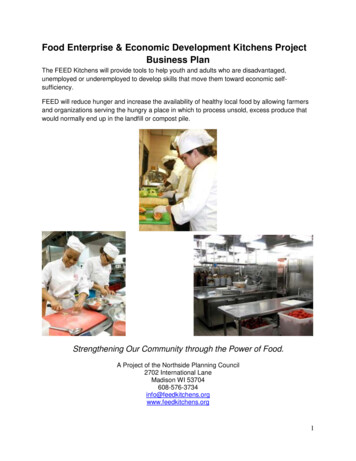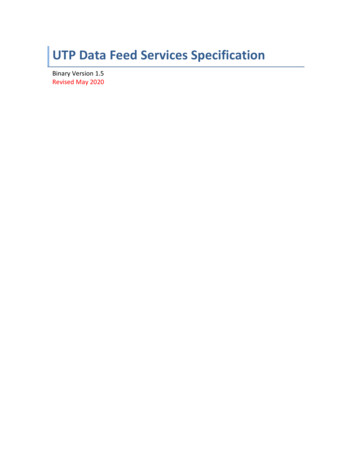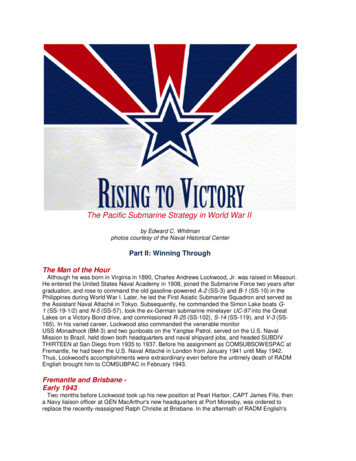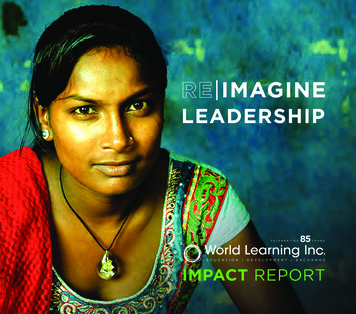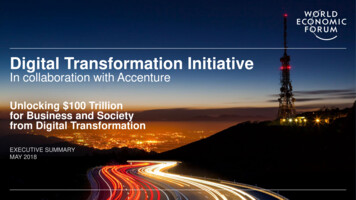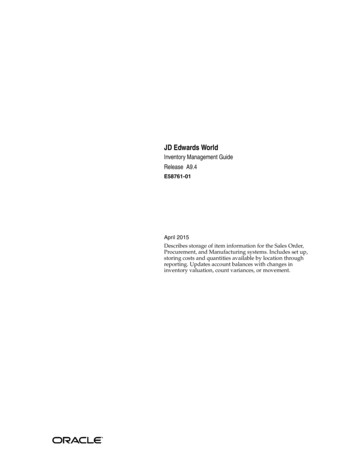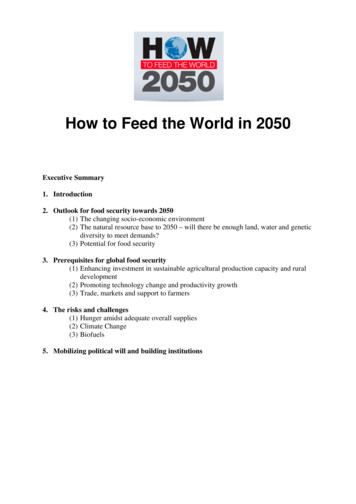
Transcription
How to Feed the World in 2050Executive Summary1. Introduction2. Outlook for food security towards 2050(1) The changing socio-economic environment(2) The natural resource base to 2050 – will there be enough land, water and geneticdiversity to meet demands?(3) Potential for food security3. Prerequisites for global food security(1) Enhancing investment in sustainable agricultural production capacity and ruraldevelopment(2) Promoting technology change and productivity growth(3) Trade, markets and support to farmers4. The risks and challenges(1) Hunger amidst adequate overall supplies(2) Climate Change(3) Biofuels5. Mobilizing political will and building institutions
2Executive SummaryBy 2050 the world’s population will reach 9.1 billion, 34 percent higher than today. Nearlyall of this population increase will occur in developing countries. Urbanization will continueat an accelerated pace, and about 70 percent of the world’s population will be urban(compared to 49 percent today). Income levels will be many multiples of what they are now.In order to feed this larger, more urban and richer population, food production (net of foodused for biofuels) must increase by 70 percent. Annual cereal production will need to rise toabout 3 billion tonnes from 2.1 billion today and annual meat production will need to rise byover 200 million tonnes to reach 470 million tonnes.This report argues that the required increase in food production can be achieved if thenecessary investment is undertaken and policies conducive to agricultural production are putin place. But increasing production is not sufficient to achieve food security. It must becomplemented by policies to enhance access by fighting poverty, especially in rural areas, aswell as effective safety net programmes.Total average annual net investment in developing country agriculture required to deliver thenecessary production increases would amount to USD 83 billion. The global gap in what isrequired vis-à-vis current investment levels can be illustrated by comparing the requiredannual gross investment of US 209 billion (which includes the cost of renewing depreciatinginvestments) with the result of a separate study that estimated that developing countries onaverage invested USD 142 billion (USD of 2009) annually in agriculture over the past decade.The required increase is thus about 50 percent. These figures are totals for public and privateinvestment, i.e. investments by farmers. Achieving them will require a major reallocation indeveloping country budgets as well as in donor programmes. It will also require policies thatsupport farmers in developing countries and encourage them and other private participants inagriculture to increase their investment.In developing countries, 80 percent of the necessary production increases would come fromincreases in yields and cropping intensity and only 20 percent from expansion of arable land.But the fact is that globally the rate of growth in yields of the major cereal crops has beensteadily declining, it dropped from 3.2 percent per year in 1960 to 1.5 percent in 2000. Thechallenge for technology is to reverse this decline, since a continuous linear increase inyields at a global level following the pattern established over the past five decades will not besufficient to meet food needs. Although investment in agricultural R&D continues to be oneof the most productive investments, with rates of return between 30 and 75 percent, it hasbeen neglected in most low income countries. Currently, agricultural R&D in developingcountries is dominated by the public sector, so that initially additional investment will have tocome from government budgets. Increasing private sector investment will require addressingissues of intellectual property rights while ensuring that a balance is struck so that access ofsmallholder farmers to new technologies is not reduced.Hunger can persist in the midst of adequate aggregate supplies because of lacking incomeopportunities for the poor and the absence of effective social safety nets. Experience ofcountries that have succeeded in reducing hunger and malnutrition shows that economicgrowth does not automatically ensure success, the source of growth matters too. Growthoriginating in agriculture, in particular the smallholder sector, is at least twice as effective in
3benefiting the poorest as growth from non-agriculture sectors. This is not surprising since 75percent of the poor in developing countries live in rural areas and their incomes are directly orindirectly linked to agriculture. The fight against hunger also requires targeted and deliberateaction in the form of comprehensive social services, including food assistance, health andsanitation, as well as education and training; with a special focus on the most vulnerable.Many countries will continue depending on international trade to ensure their food security.It is estimated that by 2050 developing countries’ net imports of cereals will more than doublefrom 135 million metric tonnes in 2008/09 to 300 million in 2050. That is why there is a needto move towards a global trading system that is fair and competitive; and that contributes to adependable market for food. Reform of farm support policies in OECD countries is awelcome step which has led to a decline in the aggregate trade distortion coefficient from 0.96in 1986 to 0.74 in 2007. However, there is clearly still room for improvement. There is also aneed to provide support and greater market access to developing country farmers so that theycan compete on a more equal footing. Countries also need to consider joint measures to bebetter prepared for future shocks to the global system, through coordinated action in case offood crises, reform of trade rules, and joint finance to assist people affected by a new pricespike or localized disasters.Climate change and increased biofuel production represent major risks for long-term foodsecurity. Although countries in the Southern hemisphere are not the main originators ofclimate change, they may suffer the greatest share of damage in the form of declining yieldsand greater frequency of extreme weather events. Studies estimate that the aggregate negativeimpact of climate change on African agricultural output up to 2080-2100 could be between 15and 30 percent. Agriculture will have to adapt to climate change, but it can also help mitigatethe effects of climate change, and useful synergies exist between adaptation and mitigation.Biofuel production based on agricultural commodities increased more than threefold from2000 to 2008,. In 2007-08 total usage of coarse grains for the production of ethanol reached110 million tonnes, about 10 percent of global production. Increased use of food crops forbiofuel production could have serious implications for food security. A recent study estimatesthat continued rapid expansion of biofuel production up to 2050 would lead to the number ofundernourished pre-school children in Africa and South Asia being 3 and 1.7 million higherthan would have been otherwise the case. Therefore, policies promoting the use of foodbased biofuels need to be reconsidered with the aim of reducing the competition between foodand fuel for scarce resources.The world has the resources and technology to eradicate hunger and ensure long-term foodsecurity for all, in spite of many challenges and risks. It needs to mobilize political will andbuild the necessary institutions to ensure that key decisions on investment and policies toeradicate hunger are taken and implemented effectively. The time to act is now.
4How to Feed the World in 20501. IntroductionThe sharp increases in food prices that occurred in global and national markets in recentyears, and the resulting increases in the number of hungry and malnourished people, havesharpened the awareness of policy-makers and of the general public to the fragility of theglobal food system. This awareness must be translated into political will and effective actionto render the system better prepared to respond to long-term demand growth and moreresilient against various risk factors that confront world agriculture, and to ensure that thegrowing world population will be able to produce and have access to adequate food today andin future. There is a need to address new challenges that transcend the traditional decisionmaking horizons of producers, consumers and policy-makers.In the first half of this century, global demand for food, feed and fibre is expected to grow by70 percent while, increasingly, crops may also be used for bio-energy and other industrialpurposes. New and traditional demand for agricultural produce will thus put growing pressureon already scarce agricultural resources. And while agriculture will be forced to compete forland and water with sprawling urban settlements, it will also be required to serve on othermajor fronts: adapting to and contributing to the mitigation of climate change, helpingpreserve natural habitats and maintaining biodiversity. To respond to those demands, farmerswill need new technologies to produce more from less land, with fewer hands.This perspective for 2050 raises a number of important questions. Are current public andprivate investments sufficient to ensure adequate agricultural production potential, sustainableuse of natural resources, infrastructure for markets, information and communication andresearch for technological breakthroughs for the future? Will resources, new technologies andsupporting services be available to the people who will need them most - the poor? Whatneeds to be undertaken to help agriculture meet the challenges of climate change and growingenergy scarcity? What can be done to ensure food security in sub-Saharan Africa, thecontinent facing the highest population growth rates, the severest impacts from climatechange and the heaviest burden of HIV/AIDS?To consider these and associated questions, FAO convened a three-day Meeting of Expertsin Rome in June 2009. The following document takes major findings of that meeting intoaccount and aims to serve as a basic background for the High-Level Experts Forum on“How to Feed the World in 2050”, to be convened at FAO Headquarters in Rome on 12-13October 2009.At the Expert Meeting in June there was consensus among participants that it should bepossible to produce enough food in 2050 to meet the needs of a world population that willhave increased to more than 9 billion, but that this positive outlook assumed certainconditions are met and policy decisions taken. Two conditions were considered essential forsuccess in meeting the expected food needs on a sustainable basis. One is increasedinvestment in research and development for sustained productivity growth, infrastructureinstitutional reforms, environmental services and sustainable resource management. The otheris that policies should not simply focus on supply growth, but also on access of the world’spoor and hungry to the food they need to live active and healthy lives.
52. Outlook for Food Security towards 2050In the following, the key elements of current expert thinking regarding the outlook for foodsecurity towards 2050 will be summarized. The key message from this assessment is that itwill be possible to achieve food security for a world population of 9.1 billion people projectedfor that time, provided a number of well specified conditions are met through appropriatepolicies.2.1 The changing socio-economic environmentThe main socio-economic factors that drive increasing food demand are population growth,increasing urbanization and rising incomes. As regards the first two, population growth andurbanization, there is little uncertainty about the magnitude, nature and regional pattern oftheir future development.According to the latest revision of the UN population prospects (medium variant), the worldpopulation is projected to grow by 34 percent from 6.8 billion today to 9.1 billion in 2050.Compared to the preceding 50 years, population growth rates will slow down considerably.However, coming off a much bigger base, the absolute increase will still be significant, 2.3billion more humans. Nearly all of this increase in population will take place in the part of theworld comprising today’s developing countries. The greatest relative increase, 120 percent, isexpected in today’s least developed countries.World Population 1965 - 205010.009.008.00Billion 7019650.00YearDeveloping countriesDeveloped countriesSource: Population Division of the Department of Economic and Social Affairs of the UnitedNations Secretariat (2007)
6All of the growth in the world’s population, and some more, will take place in urban areas.By 2050 more than 70 percent of the world's population is expected to be urban.Urbanization will bring with it changes in life styles and consumption patterns. Incombination with income growth it may accelerate the ongoing diversification of diets indeveloping countries. While the shares of grains and other staple crops will be declining,those of vegetables, fruits, meat, dairy, and fish will increase. In response to a rising demandfor semi-processed or ready-to-eat foods, the whole structure of market chains is likely tocontinue its dynamic change towards a further concentration of supermarket chains. While theshare of the urban population is growing, however, rural areas will still be home to themajority of the poor and hungry for quite some time. Currently, one billion people cannoteven satisfy their basic needs in terms of food energy. Living in hunger hot spots, oftenecologically fragile areas, many of them have to cope with conditions of high populationpressure and deteriorating ecosystems.Global progress in food consumption3000OtherPulsesRoots and e oilsOther rce: FAO (2002)Despite urbanization, rural populations will grow faster than employment in primaryagriculture, which is typically the case in transforming countries, so governments mustfacilitate the gradual transition to non-agricultural employment. This will require aninstitutional environment in rural areas that is conducive to multiple sources of employmentand income generation. In Asia and Latin America a large proportion of the rural labour forceis already working full or part-time in non-agricultural jobs. In the agriculture-based countriesof sub-Saharan Africa these shares are still much lower, especially for women. The greaterpart of the rural labour force is still employed in agriculture and depends on productivitygrowth within smallholder agriculture to improve their incomes and food security. However,as the rural population pressure is increasing, governments will have to address the ruralemployment transition here as well.
7Projections of the third key determinant of future demand expansion, income growth, aresubject to greater uncertainty. In the years preceding the recent crisis of 2008/09, economicgrowth had been particularly high in many developing regions, especially in Asia, but also inmany countries of sub-Saharan Africa. The financial crisis has interrupted this growth as aresult of a complex set of factors, which need to be addressed systematically to reduce thechances of their recurrence. Although the World Bank predicts growth momentum to turnweakly positive in 2010 and 2011, the pace and timing of the recovery is still highly uncertainand so are the consequences for the longer term outlook.So far, analysts believe that the longer-term effects of the financial and economic crisis oneconomic growth will be relatively small. Most projections of demand and supply towards2050 use the World Bank’s baseline projections of economic growth. The latest version(submitted to the FAO Expert Meeting in June 2009) implies an average annual rate of GDPgrowth of 2.9 percent during the period between 2005 and 2050, breaking out into 1.6 percentfor high-income countries and 5.2 percent for the developing countries. Over the 45 yearperiod, the rates are expected to decline everywhere to half their initial levels. A keyconsequence of this differential growth would be a major increase in developing countries’share in global output from 20 to 55 percent. As a result, the relative income gap (ratio of percapita GDP) between the two country groups will be narrowing, although absolute differenceswould remain pronounced and even increase further, given the current very large gap inabsolute per capita incomes. Moreover, inter-country and interregional inequalities within thepresent-day developing world would tend to become more pronounced.Income Growth 2004 trillionPercent per annum8160Developing country GDP (left‐axis)7140Developing country growth (right‐axis)12061005480High‐income country growth me country GDP (left axis)Source: Mensbrugghe et al. (2009)202520302035204020452050
8The future growth of food demand will be the combined effect of slowing populationgrowth, continuing strong income growth and urbanization in many of the developingcountries and associated shifts in diet structures, especially in the most populous ones, andgradual food saturation in many developing countries, as is already the case in developedcountries. Globally the growth rate of demand will clearly be lower than during precedingdecades. Nevertheless, the projected total demand increase is still significant in absoluteterms, with only small differences between the main models.Moreover, it is to be noted, that the future total demand for agricultural commodities mayexceed the demand for food and feed more or less significantly, depending on the expansionof demand for biofuels and on the technology used for the conversion of agricultural biomassinto biofuels. Hence, the development of the bio-energy market will also determine how far itwill be possible to meet the growing demand with the available resources and at affordableprices.How far future growth of incomes and food demand will be adequate to achieve food securitywill also be determined by the prospects for poverty reduction. In this context, it isencouraging to note that the secular decline of global poverty has intensified in recentdecades. However progress has not been uniform and apparently it was interrupted during thecurrent crisis. While dramatic improvement was recorded in China and several other largecountries such as Indonesia, India, Pakistan, Brazil, Mexico and South Africa. Sub-SaharanAfrica as a whole saw a large increase in the number of people living in absolute poverty andonly a small decrease in the poverty ratio.2.2 The natural resource base to 2050 – will there be enough land, water and geneticdiversity to meet demands?In comparison to the past 50 years, the rate at which pressures are building up on naturalresources – land, water, biodiversity – will be somewhat tempered during the coming 50 yearsdue to the slowdown of demand growth for food and feed. However, an expanded use ofagricultural feedstock for biofuels and ongoing environment degradation would work in theopposite direction.Even if total demand for food and feed may indeed grow more slowly, just satisfying theexpected food and feed demand will require a substantial increase of global foodproduction of 70 percent by 2050, involving an additional quantity of nearly 1 billion tonnesof cereals and 200 million tons of meat. The background to this outlook will be discussed inthe following section.Much of the natural resource base already in use worldwide shows worrying signs ofdegradation. According to the Millennium Ecosystem Assessment, 15 out of 24 ecosystemservices examined are already being degraded or used unsustainably. These include capturefisheries and water supply. In addition, actions to intensify other ecosystem services, such asthe ecosystem service ‘food production’, often cause the degradation of others. Soil nutrientdepletion, erosion, desertification, depletion of freshwater reserves, loss of tropical forest andbiodiversity are clear indicators. Unless investments in maintenance and rehabilitation arestepped up and land use practices made more sustainable, the productive potential of land,water and genetic resources may continue to decline at alarming rates.
9The available long-term perspective studies suggest that assuming such degradation is indeedstopped or significantly slowed, the natural resource base should be adequate to meet thefuture demand at global level. However, bottlenecks are likely to occur at national levels,particularly in countries where high demographic growth and the associated high growth ofdemand and limited commercial import capacity coincide with pronounced limitations of landor water or particularly low yield levels. If appropriate institutions and incentive systems areinstituted, the rural populations of these countries can play a vital role in ensuring anenhanced and sustainable delivery of ecosystem services, thus improving sustainable growthof productivity and incomes locally and generating public goods at national and internationallevels.The world has considerable land reserves which could in theory be converted to arable land.However, the extent to which this can be realized is rather limited. First, some of the landscurrently not cultivated have important ecological functions which would be lost. Second,they are mostly located in just a few countries in Latin America and sub-Saharan Africa,where lack of access and infrastructure could limit their use at least in the short term. Takingthese limitations into account, FAO projects that by 2050 the area of arable land will beexpanded by 70 million hectares, or about 5 percent. This would be the net balance of anexpansion by 120 million hectares in the developing countries and a contraction of arable landin favour of other uses in developed countries by 50 million hectares.Potential for Cropland Expansion?1200Million hectares10008006004002000Latin AmericaSub-SaharanAfricaNearEast/NorthAfricaSouth AsiaEast able land in use, 2005Additional land with rainfed crop production potentialSource: Bruinsma (2009).The availability of fresh water reserves for the required production growth shows a similarpicture. At global scale, there are sufficient capacities, but these are very unevenly distributed.Irrigated agriculture covers one fifth of arable land and contributes nearly 50 percent of cropproduction. Hence, it is extremely productive. An increasing number of countries are reachingalarming levels of water scarcity and 1.4 billion people live in areas with sinking groundwater levels. Water scarcity is particularly pronounced in the Near East/North Africa and theSouth Asia regions and is likely to worsen as a result of climate change in many regions.While supplies are scarce in many areas, there are ample opportunities to increase water useefficiency.
10Irrigation and water resourcesEast AsiaSouth AsiaNear East and North AfricaSub-Saharan AfricaLatin America and the Caribbean01000 2000 3000 4000 5000 6000 7000 8000 9000 10000 11000 12000 13000 14000Renewable water resources and irrigation water withdrawal (cubic km)Irrigation water withdrawal, 2005/2007Irrigation water withdrawal, 2050Renewable water resourcesSource: Bruinsma (2009)Biodiversity, another essential resource for agriculture and food production, is threatened byurbanization, deforestation, pollution and the conversion of wetlands. As a result ofagricultural modernization, changes in diets and population density, humankind increasinglydepends on a reduced amount of agricultural biological diversity for its food supplies. Thegene pool in plant and animal genetic resources and in the natural ecosystems which breedersneed as options for future selection is diminishing rapidly. A dozen species of animalsprovide 90 percent of the animal protein consumed globally and just four crop species providehalf of plant-based calories in the human diet.FAO expects that globally 90 percent (80 percent in developing countries) of the growth incrop production will come from intensification, in particular higher yields and increasedcropping intensity. This would be in line with past trends, but represents a major challenge forfuture private and public research, including research for greater resilience of farmingsystems.The future of agriculture and the ability of the world food system to ensure food security for agrowing world population are closely tied to improved stewardship of natural resources.Major reforms and investments are needed in all regions to cope with rising scarcity anddegradation of land, water and biodiversity and with the added pressures resulting from risingincomes, climate change and energy demands. There is a need to establish the right incentivesto harness agriculture’s environmental services to protect watersheds and biodiversity andto ensure food production using sustainable technologies.Even if globally the natural resource capacity may be adequate to achieve the 70 percentincrease in agricultural production needed to meet projected demand (without biofuels),bottlenecks exist at national levels, namely in countries with high demand growth, fragileenvironments and limited commercial capacity to import food or feed from the world markets.In order to ensure that resources are available in the required quantity and quality and in thelocations where they are needed, large additional investments need to be made. Priority
11should be given to interventions in favour of agriculture-dependent countries in which highprevalence of hunger coincides with resource scarcity and low yields.Increased investment, effective regulation and incentives are needed with regard to allthree natural resources required for sustainable and stable production growth: land, water,biodiversity. The aim should be to stop over-exploitation, degradation and pollution, promoteefficiency gains and expand overall capacities as appropriate. Adequate regulation andincentives are also needed to provide the rural population engaging in ecosystem serviceswith win-win solutions to improve the sustainability of ecosystems, mitigate climate changeand improve rural incomes.2.3 Potential for food securityThe projections for the future socio-economic environment and the assessment of the situationand prospects of the natural resource base raise the question as to whether and under whatconditions the estimated future food demand can be met and how food security can beachieved.Based on the projected growth of population and incomes and expected changes inconsumption patterns, the FAO estimates future consumption levels for various commoditiescountry by country. Taking into account countries’ known resource capacities and projecteddevelopment of yields, input use and technologies, and making assumptions about theirfuture trading capacity, estimates are also made of future production levels, land use andtrade. At the same time, on the basis of available information concerning the distribution ofincomes and access to food within countries, the future prevalence of hunger is estimated interms of the proportion of populations not having access to an adequate level of food energy.FAO’s long-term perspective studies thus seek to assess the implications of the projectedsocio-economic and demographic environment for future demand growth and to ascertain theextent to which individual countries and the world as a whole can meet this demand throughproduction and trade and improve food security, based on reasonable assumptions aboutresource and productivity growth potentials.According to FAO’s baseline projections, it should be possible to meet the future food andfeed demand of the projected world population in 2050 within realistic rates for land andwater use expansion and yield development. However, achieving this will not at all beautomatic and several significant challenges will have to be met.The global average daily calorie availability would rise to 3050 kcal per person, a 10percent increase over its level in 2003/05. To achieve this, global cereal production wouldneed to increase by 40 percent overall, or by some 900 million tons between the 2006/08average and 2050. The advent of biofuels has the potential of changing all that and causingworld demand to be higher, depending on the energy prices and government policies. Withoutbiofuels, much of the increase in cereals demand will be for animal feed to support thegrowing consumption of livestock products. Meat consumption per caput for example wouldrise from 41 kg at present to 52 kg in 2050 (from 30 to 44 kg in the developing countries).Should this perspective be realized by 2050, the level of per-caput food availability will stillvary widely between countries, although at higher levels. Industrial countries will haveaverage availability levels of nearly 3600 kcal/person/day; the developing countries as agroup may reach almost 3000 kcal.
12Source: FAOTo reach those levels of food availability, countries can either increase production orincrease net imports of food or a combination of both. According to FAO’s long-termprojections towards 2050, today’s group of developing countries is projected to provide mostof the projected consumption growth by expanding their own production. However they willalso increase their food imports significantly. For example, the developing countries’ netimports of cereals are projected to more than double from 135 million metric tons in 2008/09to 300 million metric tons in 2050. The developed countries will be able to increase theirexport potential accordingly. On their part, the developing countries will be growing netexporters of other food commodities like vegetable oils and s
used for biofuels) must increase by 70 percent. Annual cereal production will need to rise to about 3 billion tonnes from 2.1 billion today and annual meat production will need to rise by over 200 million tonnes to reach 470 million tonnes. This report argues that the re
